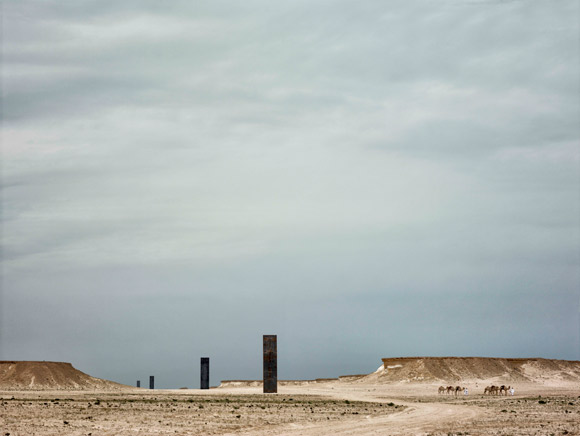Richard Serra, a very well known American minimalist sculptor, composed a breathtaking set of sculptures in the middle of Qatar's desert. His new sculpture series, “East-West/West-East”, is composed of four standing steel plates, which were rolled in Germany, shipped via Antwerp, and trucked all the way to Qatar.
“East-West/West-East,” is considered to be one of the most leading pieces of Serra’s creations and is yet another grand piece of public art purchased by Qatar Museums Authority, which is estimated to spend about a billion dollars per year on artworks from all over the world. Sheikha al-Mayassa Hamad bin Khalifa al-Thani, a sister of the Emir of Qatar, a Duke University graduate, and the head of the Qatar Museums Authourity, was recently known for being one of the most prominent characters in the current art industry.

Serra mentioned that Qatar have given him the opportunity to work on gigantic projects that he couldn’t possibly have worked on anywhere else since Qatar has a lot of untouched space. Serra’s main attraction about Qatar does not revolve around the country’s political and social status, but rather his ability to work diligently. But of course, the location does play a crucial role in terms of presentation. The western Qatar desert isn’t a place where you can grab a cup of coffee and chill. It’s a raw place for Serra’s sculptures. It feels as if his organic sculptures belong there. It seems successfully natural, like they were meant to be there. It is a place that can be in the midst of a sandstorm, any time, any day.
Also, it’s a project that will only attract people who are truly into Serra’s work or minimalist sculptures in general. People will drive or walk all the way to the desert with a prominent purpose and I think that is what Serra wants. Looking at where Serra has showcased his work, he does not want his sculpture to be convenient or easily seen. He wants the viewer to be excited enough to go all the way to these specific locations in order to experience the true essence and nature of his work.
In terms of how long the sculptures will last, Serra admits that no one knows including himself. However, he thinks that they will last for a very long period of time. Maybe they will last a lifetime, who knows? The plates/sculptures will go from gray to orange to brown, until they turn into a dark amber.
![]()
Serra mentioned in a past interview that he’s less interested in the idea of a desert than the sea. He never really intended to work in this type of environment. However, he mentioned that this is a once in a lifetime kind of condition. This desert is like no other, mysterious and exquisite.
I have personally seen some of Serra’s work at the Dia Foundation in Beacon, New York. They were mostly spiral pieces in which you were supposed to enter. It was certainly a mysterious kind of experience since I was not certainly sure If I was supposed to go inside. It was sort of like a maze. You get this unusual feeling due to the sculpture’s environmental effect. Your imagination is the most important element. But, what makes these Qatar sculptures different is that you are actually in a mysterious place, which is the desert, rather than a gallery or a large space. It glorifies the effect even more and takes it to a whole new level.
I would love to go to Qatar right now to look at those fascinating sculptures! Who’s with me?
For more information about Richard Serra in Qatar, visit www.richardserraqatar.qa







